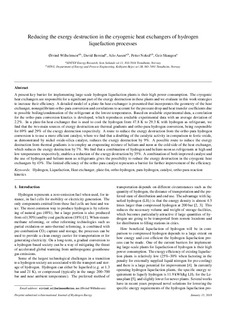| dc.contributor.author | Wilhelmsen, Øivind | |
| dc.contributor.author | Berstad, David Olsson | |
| dc.contributor.author | Aasen, Ailo | |
| dc.contributor.author | Nekså, Petter | |
| dc.contributor.author | Skaugen, Geir | |
| dc.date.accessioned | 2018-03-07T12:28:13Z | |
| dc.date.available | 2018-03-07T12:28:13Z | |
| dc.date.created | 2018-01-16T12:33:39Z | |
| dc.date.issued | 2018 | |
| dc.identifier.issn | 0360-3199 | |
| dc.identifier.uri | http://hdl.handle.net/11250/2489237 | |
| dc.description.abstract | A present key barrier for implementing large-scale hydrogen liquefaction plants is their high power consumption. The cryogenic heat exchangers are responsible for a significant part of the exergy destruction in these plants and we evaluate in this work strategies to increase their efficiency. A detailed model of a plate-fin heat exchanger is presented that incorporates the geometry of the heat exchanger, nonequilibrium ortho-para conversion and correlations to account for the pressure drop and heat transfer coefficients due to possible boiling/condensation of the refrigerant at the lowest temperatures. Based on available experimental data, a correlation for the ortho-para conversion kinetics is developed, which reproduces available experimental data with an average deviation of 2.2%. In a plate-fin heat exchanger that is used to cool the hydrogen from 47.8 K to 29.3 K with hydrogen as refrigerant, we find that the two main sources of exergy destruction are thermal gradients and ortho-para hydrogen conversion, being responsible for 69% and 29% of the exergy destruction respectively. A route to reduce the exergy destruction from the ortho-para hydrogen conversion is to use a more efficient catalyst, where we find that a doubling of the catalytic activity in comparison to ferric-oxide, as demonstrated by nickel oxide-silica catalyst, reduces the exergy destruction by 9%. A possible route to reduce the exergy destruction from thermal gradients is to employ an evaporating mixture of helium and neon at the cold-side of the heat exchanger, which reduces the exergy destruction by 7%. We find that a combination of hydrogen and helium-neon as refrigerants at high and low temperatures respectively, enables a reduction of the exergy destruction by 35%. A combination of both improved catalyst and the use of hydrogen and helium-neon as refrigerants gives the possibility to reduce the exergy destruction in the cryogenic heat exchangers by 43%. The limited efficiency of the ortho-para catalyst represents a barrier for further improvement of the efficiency. | nb_NO |
| dc.language.iso | eng | nb_NO |
| dc.publisher | Elsevier | nb_NO |
| dc.rights | Attribution-NonCommercial-NoDerivatives 4.0 Internasjonal | * |
| dc.rights.uri | http://creativecommons.org/licenses/by-nc-nd/4.0/deed.no | * |
| dc.title | Reducing the exergy destruction in the cryogenic heat exchangers of hydrogen liquefaction processes | nb_NO |
| dc.type | Journal article | nb_NO |
| dc.type | Peer reviewed | nb_NO |
| dc.description.version | acceptedVersion | nb_NO |
| dc.source.journal | International journal of hydrogen energy | nb_NO |
| dc.identifier.doi | 10.1016/j.ijhydene.2018.01.094 | |
| dc.identifier.cristin | 1544035 | |
| dc.relation.project | Norges forskningsråd: 255107 | nb_NO |
| dc.description.localcode | © 2018. This is the authors’ accepted and refereed manuscript to the article. Locked until 16.2.2020 due to copyright restrictions. This manuscript version is made available under the CC-BY-NC-ND 4.0 license http://creativecommons.org/licenses/by-nc-nd/4.0/ | nb_NO |
| cristin.unitcode | 194,64,25,0 | |
| cristin.unitname | Institutt for energi- og prosessteknikk | |
| cristin.ispublished | false | |
| cristin.fulltext | postprint | |
| cristin.qualitycode | 2 | |

